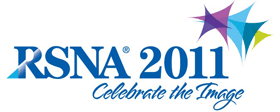
Abstract Archives of the RSNA, 2011
Kathryn Jane Stevens MD, Presenter: Nothing to Disclose
Pauline Wong Worters PhD, Abstract Co-Author: Nothing to Disclose
Garry Evan Gold MD, MSEE, Abstract Co-Author: Consultant, Zimmer Holdings, Inc
Consultant, ICON plc
Consultant, ArthroCare Corporation
Research support, General Electric Company
Jarrett Rosenberg PhD, Abstract Co-Author: Nothing to Disclose
Brian Hargreaves, Abstract Co-Author: Nothing to Disclose
Spinal surgery is not always successful at alleviating back pain or radicular symptoms, and may result in failed back surgery syndrome. MRI is often of limited value in patients after instrumented fusion, due to metal artifact from spinal hardware, particularly at higher field strengths. The purpose of our study was to determine whether Slice Encoding for Metal Artifact Correction (SEMAC) could improve MR imaging of the lumbar spine in patients with residual or recurrent back pain or radicular symptoms following instrumented spinal fusion.
10 patients with prior spinal fusions were scanned on a 1.5T GE scanner. Sagittal and axial 2D FSE and SEMAC images were acquired using a multi-channel receive-only lumbar coil. Flexible k-space trajectory schemes were used to maximize acquisition efficiency and reduce scan times. SEMAC images were reconstructed using sum-of-squares combination. Paired sagittal and axial 2D FSE and SEMAC images were viewed by 2 MSK radiologists, and graded for metal artifact, visualization of adjacent anatomy and overall image quality using a 5 point scale (-2 for SEMAC much better than 2D FSE, 0= equal, +2 2D FSE much better than SEMAC). Ratings were analyzed using a Wilcoxon signed rank test.
SEMAC images had significantly less metal artifact than 2D FSE (p<0.0001), allowing improved visualization of anatomic structures next to the implant (p<0.0001), leading to a perceived higher overall image quality (p<0.0001). Metal artifact was greatest in a patient with transarticular facet screws at L5-S1, where the spinal canal and neural foramina were obscured by artifact on 2D FSE, but were well seen SEMAC. Inter-observer agreement was high, with kappa scores of 1, 1 and 0.83 for metal artifact, adjacent anatomy and overall image quality respectively.
MRI of patients after instrumented spinal fusion is often limited by local inhomogeneities in the main magnetic field induced by metal, resulting in image artifact and inhomogeneous fat saturation near the fusion hardware. Significantly less imaging artifact was seen with SEMAC, leading to better visualization of anatomic structures in the vicinity of the metal, which we hope will translate to improved diagnostic yield on post-operative MRI.
SEMAC is a promising new metal-suppression MRI technique for evaluating the spine in patients with residual or recurrent symptoms following instrumented spinal fusion.
Stevens, K,
Worters, P,
Gold, G,
Rosenberg, J,
Hargreaves, B,
MR Imaging after Lumbar Spinal Fusion Using Slice Encoding for Metal Artifact Correction (SEMAC). Radiological Society of North America 2011 Scientific Assembly and Annual Meeting, November 26 - December 2, 2011 ,Chicago IL.
http://archive.rsna.org/2011/11010255.html

